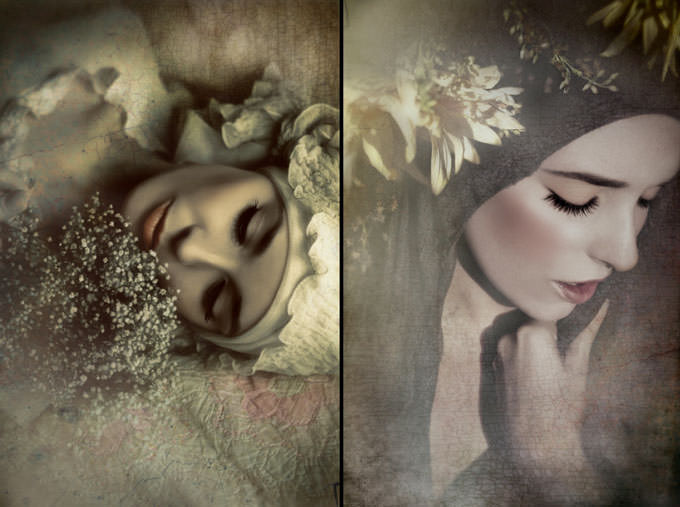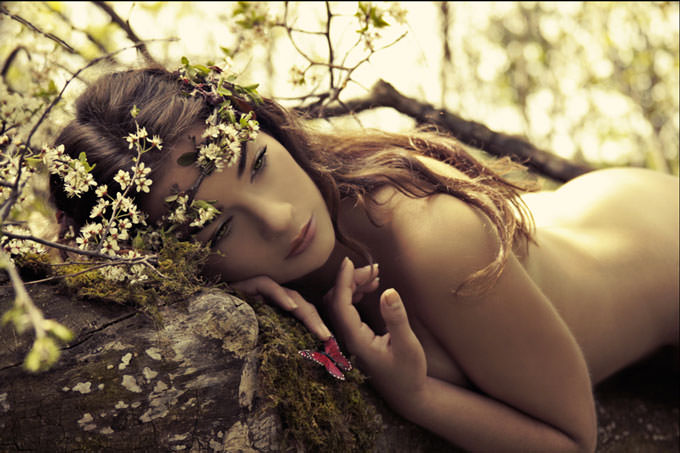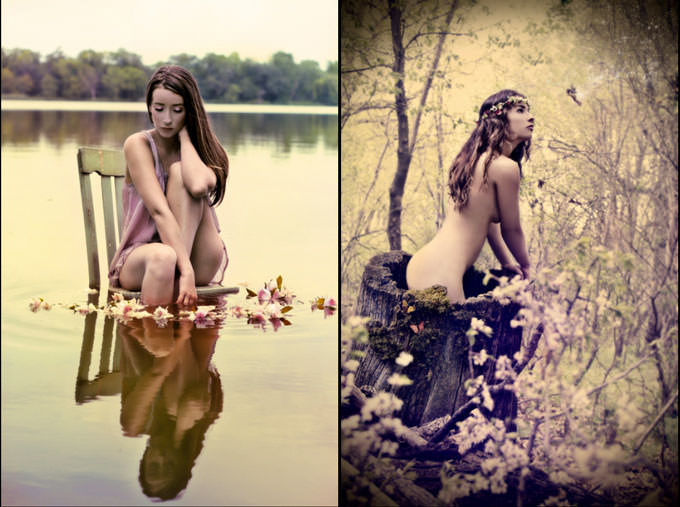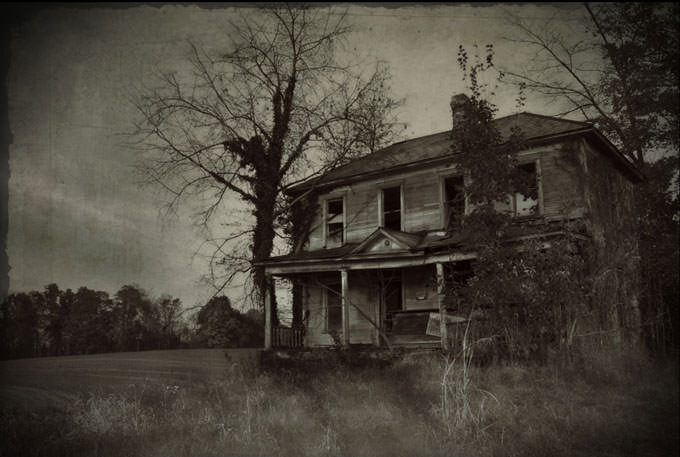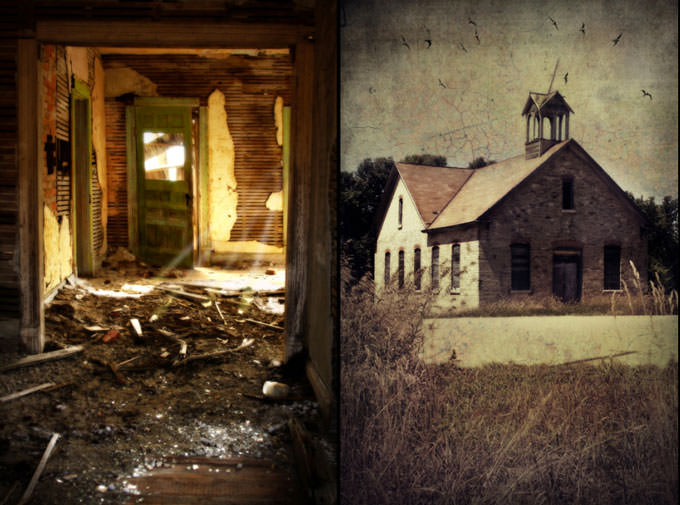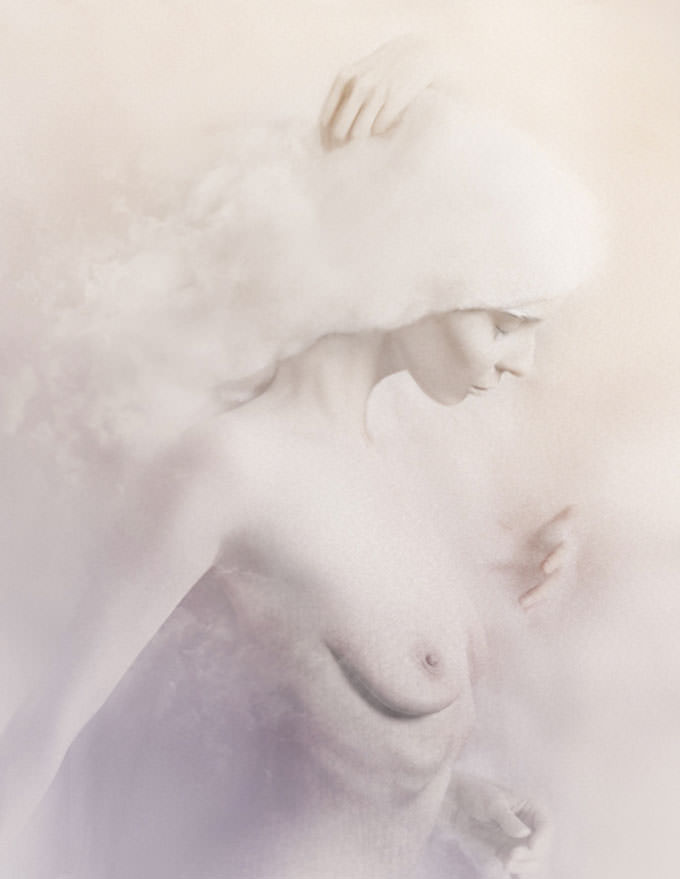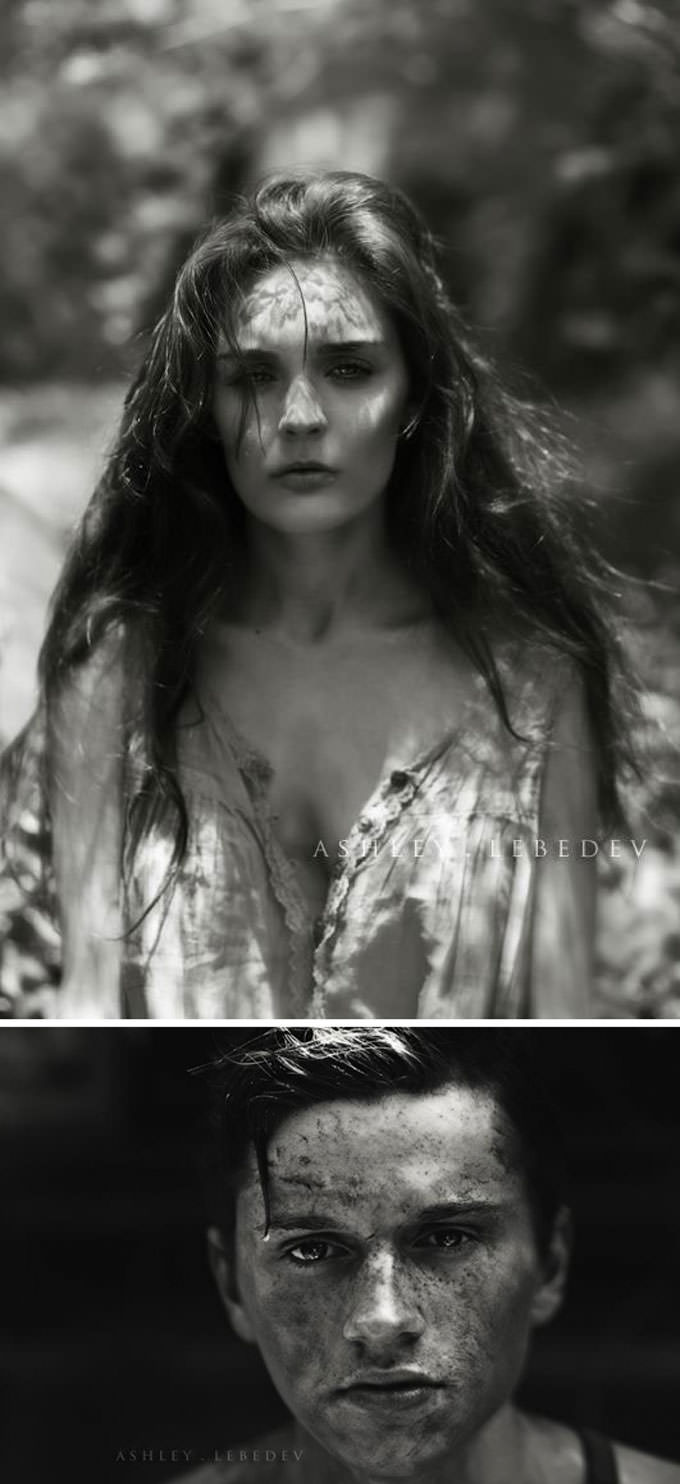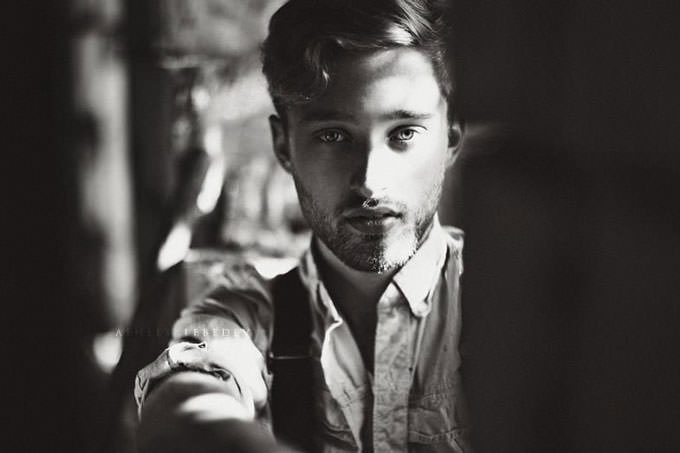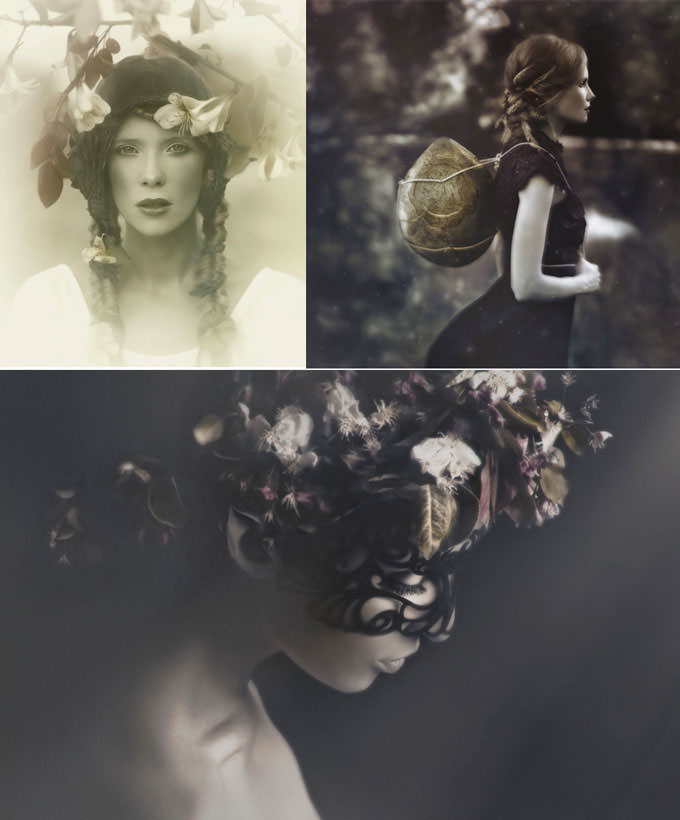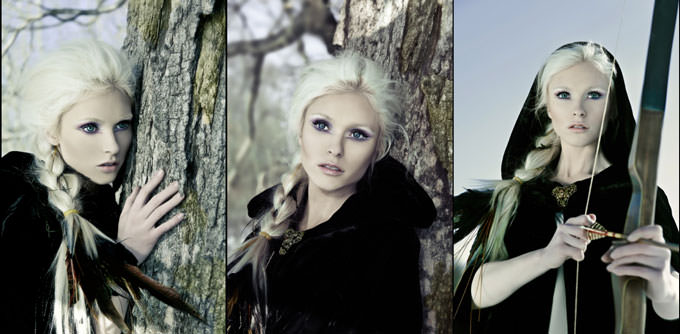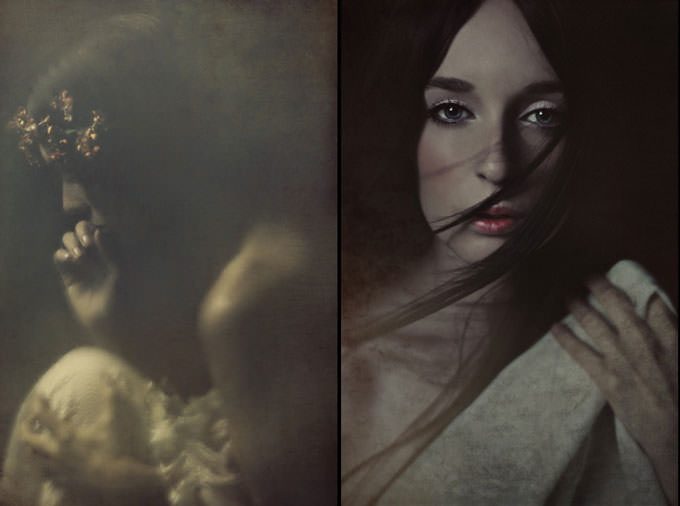
Interview with Bottle Bell
Ashley Lebedev, of Bottle Bell Photography, is a 29-year-old artist and fine art photographer, specializing in conceptual portraiture. After attending school for commercial photography, Ashley chose to venture away from conventional photographic styles, and developed a taste for telling stories through her photographs.
PHLEARN got the chance to go in-depth and personal with Ashley in this extended interview, where she talks about her choice to pursue fine art photography and the difficulties that came along with that. Ashley also talks of her struggles of learning how to live within the confines of an illness, and how art can be used as a therapy.
Please Note: Some of the photos in this interview are NSFW
How did you become interested in photography?
My story isn’t so dissimilar from the many I hear from other photographers in the industry. It sort of begins with finding a camera and the feelings we all realize we have towards things related to capturing life in this way, the very moment that event happens.Specifically, it was the Summer of 2006 or 2007. I’d just left a long relationship and was living a very stressful, overscheduled life, especially work-wise (was running a non profit organization for people with mental health disorders all by myself) and I was burnt out. I took a long week off on advice from a friend and went back to one of the farms I’d grown up on.
I remember that week being a reintroduction to country after too many years in the city. It was quiet, it was healing. I hadn’t heard wind without sirens or even been alone in so long. It was an immediate reset. During that time back home, I found an old vintage Pentax sitting in the closet of my old room. I, all of the sudden, had downtime to play with new things, new ideas and so I did some self portraiture that week/weekend, which I ended up posting on a site called Flickr, way way back when.
In that week, I realized it’s all I wanted to do and began to make that a habit. Needless to say, I shut down the non profit because my heart wasn’t in it. My heart was in expressing ideas through pictures. I realized I had a lot of ideas and a lot I’d needed to say, that worked to express in that way and only that way and so, it began.
Where does the name Bottle Bell come from?
You know, it’s a simple story, really. I was just out walking a property one day at the beginning of my time behind a camera and learning how to take a photograph and I was kicking about in the woods which for me, is a pretty common activity, and I saw this old bottle half buried in the dirt. I unearthed it and kept walking with it in my hands. It was just a standard old green glass bottle maybe about 30 or 40 years old, really naturally textured and worn.
At some point on that walk, I ended up blowing across the mouthpiece. We’ve all done this to a bottle at some point I think? And, it made that beautiful, haunting, low hum of a sound and I just remember saying or thinking “oohh, it’s a big bellowing sound” and it seemed very symbolic for how we take or make photos in that I saw this bottle and brought it to life by blowing across the mouthpiece. I think it’s similar with what we do in taking or making an image. We bring an idea to life by adding a piece of ourselves, however we come to it.
It woke up when I interacted with it, when I added in a little energy. I like the idea of bringing things to life by giving to them a bit of our own life (my breath on the bottle, for instance, or my imagination translated through lenses onto models) and that brought me to the name Bottle Bellow, to honor that metaphor. I later shortened it to Bottle Bell because I liked the sound of it.
In the last few years, I’ve wanted to get away from that metaphor and just go with my name for ease of marketing without confusion of two names, but answering this question gives me an appreciation for the beginnings of things and the beginning of my little endeavor.
After spending many years on the commercial side of photography you have decided to do a complete 180, and now you shoot only fine art photography. What happened to provoke the change?
If I’m being very honest, the short answer is simply that my heart was never in commercial work. And believe me, I tried. I am NOT a commercial photographer, at least not for the most part. I know a lot of photogs are right here at this sentence reading it with the thought “I LOVE commercial work” or they are thinking “I DON’T WANT TO BE DOING THIS” and for me, it was the latter. I’m not unique in that.
As much as I tried, it felt entirely empty at the end of the day and it was an exhausting process to bend my creative ideas around concepts or places that ultimately didn’t inspire me. I didn’t like having to rework edits or soften a concept to fit the ideal of another person paying me to use my own voice.
After years and years of already working for others in other companies and other vocations and then finally finding my passion of what I wanted to do and walking away from jobs, no matter the industry, I felt like taking on commercial work wasn’t necessarily something I could do any further or even should do any further, not only because it didn’t inspire me but because I was watching my creativity stagnate in the process.
For me, it was the thought that If I didn’t like working for other people at other companies, I really wanted to assess why I’d even bother to start my own, only to work for other people again and make them my bosses.
I did an examiner interview a number of years ago that touched on this and I want to pull from that. I feel like when you take on a commission for someone else, you are agreeing (no matter the amount of creative control) to tell their story or stories or to, at the very least, bend your own story to meet theirs in the middle, because a commission commits you (often, not always) to sharing a vision which is ultimately a departure, big or small, from your own. For me, I was too much of a die hard artist to be able to find a balance there.
So, I didn’t think it was fair to myself or anyone else, especially to families or people getting married, to tell their story through my lens without having the passion to tell their story properly or to follow through with having the energy to fall in love with their stories.
I guess a good way of putting it was that I felt like I wouldn’t be telling my story or their story, ultimately. I’d have just been sort of fulfilling a contract. Fulfilling a contract is NOT fulfilling when it feels like that.
My hat is absolutely off to commercial photographers. I know a ton of people are fulfilled and in love with this part of the industry. That makes me happy & those are the people that should be doing it; the people who have the heart around it.
It was good to go through this part of my career though, because I think it’s necessary to know if it’s where you love to be, or if it’s the first step in realizing it was a stepping stone in growing. Regardless, it’s an invaluable learning experience and one I’ve learned from.
We are all so different.
I now take on very selective commissions, maybe 2 or 3 a year, that I know I can commit my heart to and tell with the energy and time it deserves. I hold out for those and walk away from everything else. I’m too focused on my own imagination for now.
What do you think are the the downfalls of choosing fine art photography over commercial?
Of course the answer to this, for anyone who’s done it, is money. It’s harder at times, to work for yourself and not book your schedule with jobs that guarantee monetary stability.
Fine art allows a lot of freedom and concentrated passion around my own concepts and ideas but it can definitely be unnerving from time to time. That’s also been a learning experience and exercise in balancing both.
Are there any aspects of shooting fine art photography that simply can’t be enjoyed by shooting commercial photography?
As mentioned above, I think just the freedom to express entire creative control around my shooting. As an example of this, especially on things like Faerieland, especially with the work on the horizon line this year, I just get to show up and design my own worlds, my own characters, every color and texture, the makeup, the set, the location and clothing piece my model wears.Even in post, I edit it to fit my aesthetic and it’s the truest I can be to an idea.In contrast, commercial photographers gain great amounts of knowledge around working with such different kinds of people and on such a regular basis. I think commercial photogs become such awesome pros of things that become necessary on a shoot with people you’ve not had a lot of interaction with before shooting, such as improvising a concept or location or how to produce a lot of work in a short period of time. Those are skills.I also think commercial photographers just ‘see’ differently, so to speak.
Different facets of this industry, different titles: fashion, beauty, commercial, conceptual, fine art, we all approach our work differently and our ideas vary greatly and so do our strengths. I really admire commercial photographers sometimes for how they see a family and how they put that family together, working in the most fluid way, expressing each personality in a way that the family relates to.
In weddings, bringing a memory to an event with the feeling that relays JUST how it was that day.I’d struggle with being able to do that. Those are absolute talents to be able to do that. For me, I’ve nurtured this genre and branch of the industry and so I excel in other things.
One of my very good friends here in Portland has a commercial photography business and she’s very good at it. She works a lot with children and families, and I remember seeing her children portfolio the other day and just internally remarking to myself how impressed I was that she can photograph so many people and still maintain a unique shoot every time. She laid a child in a bird bath and I just loved the simplicity of that and thinking on her feet style she has mastered.
I think commercial photographers develop a very unique intuition and style of improvisational shooting and can read people in a very unique ways.
How long after graduating from school did you decide to switch from shooting commercial to fine art photography?
Well, it’s funny, because I actually left school because I didn’t like the way it was taught and for a few years didn’t think I liked photography at all. Turns out, I just didn’t like the teacher or the way it was shown to me. So, I attended school back in my teens for commercial photography and didn’t find my way back to a camera until my mid-twenties.
As well as being a photographer, you are a poet and a writer. Is your photography ever inspired by your writings or poems (and vice versa)?
Entirely. I am heavily inspired by the work of John Keats, Tennyson, Neruda, Kerouac, Steinbeck, Proust. I find often that I’ll write a poem or continue on this novel I’ve been chipping away at since 2011 and that it’ll show up in my work or that an image I make inspires a next chapter or piece in my writing endeavors.These are all expressions of us, our diary and since they all come from within us, a place where very few divider lines exist, there’s always an overlap of one way of expressing to the other. I love this part of creating. I also think it’s really healthy for artists to experiment to find what forms of creativity they love since it’s not often just one. I’d encourage everyone to not limit themselves just to fit within the guidelines of one title.
What’s on your equipment list?
I work on a broken Canon 5D Mark II and I love prime lenses, owning the 85, 50 and 35, among a few others that I don’t use at all. I have, from time to time, had lighting setups, like Alien Bee, which are great, but I never used them. I work in all natural light and love to challenge of perfecting it simply. I edit in Adobe Photoshop and Lightroom and work inside of my own actions if any.
Your series of photographs titled “Forgotten” provokes feelings of eeriness, isolation, and loneliness. Each image seems relatively simple but feels emotionally complex. What has inspired this series of photographs?
I hear this sentiment around all of my work, even the portraiture, even the ones I think are my happier ones. My ex used to say my work was “an emotional abyss with a little bit of hope,” which I used to laugh at because I didn’t see it that way.
As far as the “Forgotten” work, I think it’s just an extension of how I, specifically, connect to things and how I perceive them. A number of years ago, I think I really fell head first in love with photographing forgotten structures. I find I photograph them with a lot of energy and heart because they haven’t had any in a while and because they show their state very honestly to a lens, which isn’t always the case with other subjects, like models. It’s very different than photographing a model or landscape, in that models and landscapes are still both fluidly changing and being something alive.
Though an abandoned building or house (I gravitate towards houses especially) is still changing, it doesn’t feel like it’s still growing. The opposite in fact, it feels like it’s served its purpose and I try to document whatever that might have been, perhaps from the perspective of what it’d feel like in retrospect, being left to that disrepair for whatever reason.
I know when I document houses, especially, and in doing this so much again these last two months after many years of taking a break, that I do a lot of respectful looking around the house and sitting in those spaces, listening. I think it’s my way of paying homage. I try to figure a house out. There’s a very human and personal element to them. I am absolutely fascinated by them.
Who are your biggest inspirations?
The pre-raphaelite painters like John William Waterhouse and the work of Maxfield Parrish. Their colors and subjects are idyllic. They are dreamscapes. You can get lost in any one of them. I love their intimacy and commitment to feminine brilliance as well as maintaining truth to relaying actual femininity which is not about high heals and lipstick, but about understanding a sort of inherent softness.
As for the image that made me appreciate photography for the first time and want to capture real, honest, non contrived emotion, there’s an image by Dorothea Lange in her documenting a migrant mother that I remember use to shake me when I first picked up a camera. It doesn’t do that quite the same now that I’ve grown these last seven years, but there’s a lot of power around what shapes our beginnings. The person who can do that now is Sally Mann, specifically her ‘Family Portrait” Body of work.
As for people today that I truly look up to currently working around me, I really am inspired by Brooke Shaden. We share a lot of the same love for moody Color palettes and photographing women, but I also think I like her so much because she’s inspired completely separately from taking a photo.
I like when people understand how to inspire themselves through life and implement that into a daily practice. The same can be said for perhaps my greatest unintentional mentor, whether he knows it or not, the very talented Erik Almas. Erik is just one hell of a talented and humble guy. He understands light and his subjects and I think it’s because he understands himself and how to express himself.
He’s a success story that I think earned itself. I also really admire that he has made a practice of turning nearly all of his commercial work into personal work with so much heart and palpable sincerity that now he’s paid to do it for a living. His work is seamless too which I greatly admire and he deserves a lot of recognition for being a male photographer that can photograph a female in a way that a female would actually want to be photographed. Erik is great at this, which I find a rarity in male photographers, usually capturing some degree of inherent beauty without tan lines and awkward poses. It’s natural.
Natural isn’t done enough, in my opinion. His work is also incredibly conceptual for being/becoming so mainstream and Brooke is the same. I love conceptual work for the most. Both of them can take anything and make it imaginative, make it tell a story.
Many of your conceptual portraits have a very maternal quality to them. Is this something that was intentional or is it perhaps just my read of it?
I think that’s definitely something I don’t do intentionally but I do see that I continue to do it when I look back at a body of work. It’s never the goal beforehand, but ends up coming out in the image.Again, I think it’s just my way of interpreting a woman and tying those to concepts I find beautiful. There’s also a lot of letting a model be to some degree, very simple and gently guiding them to soften so I can capture that unique thing, so I think it might inherently just be a woman being a woman, even when I dress her up.
What is your favorite photo you’ve ever shot?
“Elemental,” probably. It was just a last minute self portrait one day for Faerieland that came together as so much more than I’d hoped for it. My mother has it on her wall back at home and when I walk by it, I still stop and appreciate it. I feel it’s just so much emotion for being so quiet. That’s the only image I’ve ever taken that does that after so long.
Can you tell us about your project, “Dust Bowl”?
Dust Bowl is a brainchild project that I don’t yet see an end for, though I know one day it’ll come. It started after seeing a show that used to be on HBO called “Carnivale” which basically followed a traveling Carnival through the United States during the Great Depression Era in America.The show was aesthetically gorgeous and incorporated little tiny pieces of history into the storyline, around people surviving through an incredibly hard time in history, monetarily and I wanted to begin a collection that could tie my absolutely endless love for History with things I also love like cinematic imagery and fashion and beauty. I wanted images in Dust Bowl to be almost as if you could have found them sitting in a box in your grandmother’s attic, somewhere in the Great Plains (which I’m very attached to because I was raised there) and something you might see in a Hollywood movie.
I wanted Dust Bowl to be a gorgeous way to break a heart. Dust Bowl needed to be more snapshot style and more shooting from the hip and because I wanted a series that would honor the time, I chose to make it B&W. This year, I’m beginning to shoot both the elderly and children as well as non ‘models’ so that the series can really be the most honest, almost oversimplified way of weaving together a believable, everyday, story.
It’s just a simple story of the human element. My intention for this collection is to put something together that can only work so powerfully as a whole storyboard, keeping every concept relatively simple while people grow with the characters and scenery and expressions.
Is it emotionally tolling on you when shooting and editing images for the project “Dust Bowl” because of the sensitive content?
On the contrary. Dust Bowl is the easy one. I am in love with the concepts, however sad they might be. I just find it fun to dress people up to look destitute and have the bulk of makeup and hair be disheveled, in dirt. There’s so much hoopla around Faerieland being so ideal and perfect sets and perfect models and perfect light so I really just like showing up to an un-staged set and with a model and just taking a photo.
Also, because there’s very little editing done OOC in Dust Bowl, it’s often very therapeutic and I go back to Dust Bowl when I’m needing editing down time.
That collection was born out of a need for balance.
I want Dust Bowl, just like Faerieland, to be available in a book someday. The work isn’t best off a computer. You can really see the dust and the expression in the eyes, in a big print or something you can hold and touch. I never realize how much until I see an image in print. Every photographer knows the power of that moment when they see their work for the first time in print. That’s the best feeling. That’s my hope for Dust Bowl.
What is your proudest moment as a photographer?
There are so many. What a tough question! I think my proudest moment as a photographer, beyond the fancy commissions I’ve had the absolute honor to be a part of, is just helping people in mentoring sessions one-on-one, especially when mentoring sessions become emotional. I really like sessions when I can see how powerful it is to teach and help someone one-on-one and when I see people hit a wall which ties so closely with their entire life. I like when we grow there like that. That’s my favorite.
There’s also something really amazing about going into a bookstore and seeing my work on the front shelf or being used on a best seller. I usually grab it and go sit in a corner all alone and have a quiet moment while I take it in.
Before shooting do you regularly sketch your vision beforehand?
You know, I actually don’t sketch, but I usually have a laundry list of things that go into a shoot in a composition book which I have with me until the shoot is completed. Things I do utilize very often though, are bringing natural textures onto set that I’ve collected of color palettes or pieces of nature that I want to remember.
Instead of sketches, I usually end up with tattered pieces of collected fabric, lots of screenshots of inspiring work (Pinterest is great for this part of my job) and a big bowl or clipping of natural palettes.
How much editing really goes into an image? Could we see a before/after of one of your most edited shots?
Sure! There is a segment in Faerieland called “The Guardian” and at the end of the shoot, my model broke the egg accidentally and the sun was setting and I was, for all practical purposes, done with the shoot and then the sun started cracking that perfect light over the farm’s yard and she leaned her head down and that last little inspired piece of me just said “act like you are hugging the egg!” to my model on a whim because I saw something beautiful to photograph and so she did, and my exposure was completely wrong as the light kept such a heavy contrast so low in the sky, and she was just in my driveway since we were walking back from location, so it wasn’t the right location.
But, it was a beautiful expression and shape and so I just kept that on a hard drive for a long time until I decided to make “Through the Forests of Bastian” where I decided to make that character a traveler and put her into a mini forest which was meant to not look mini, necessarily.
The forest she is in with the hands was taken almost a year later, maybe even longer, in some dried flowers I had sitting inside of a stand alone record player in my minneapolis apartment, which I photographed in similar Light at the end of another sunny day when I noticed the cool shadows it was making.
In Photoshop, I decided to merge those two images together and then make her basically sheltering the egg from these hands reaching for it. The hands are my hands, also photographed separately and tweaked to fit onto the branches, and so an image was made of those three separate shoots.
It’s so different from the beginning one and took so much trial and error in Photoshop trying to make it look believable and then to make it beautiful enough for Faerieland. I’d say that image took days, which is about how long my longest images take.
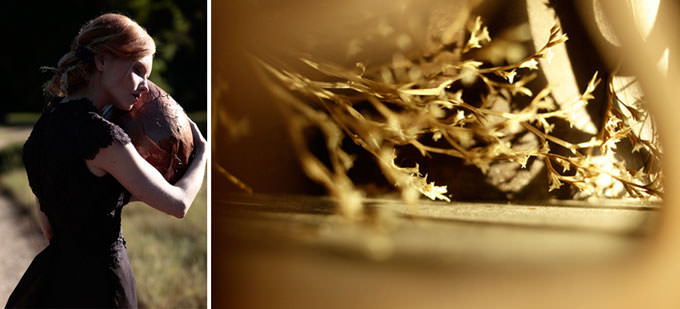
Images Used for Final Product

Final Image: Through the Forests of Bastian
Do you have any projects planned for the future?
YES. Big ones. There is a lot that I’m biting my tongue about happening this year, so cross your fingers and toes. I’m just so excited for this year.
What advice would you give to someone who was wanting to pursue fine art photography?
Let go of your fear because the only thing stopping you from achieving your dreams is the excuse you keep telling yourself or allowing yourself to rest on or believe. If you want to be a fine art photographer, or fine artist in general, learn your craft, find your voice and make a leap.
It requires courage and a lot of trial and error but so does everything. I’s just a matter of understanding change and embracing a transition. Move in the direction you want to be moving in. There’s a quote that I have found, at least for me, that applies to my leap from one to the other (and it won’t suit all, as it only worked for me because it’s what I am supposed to be doing/what brings me my happiness) which is simply, “Don’t let the good things get in the way of the best things.”
For me, it was fine art.
What obstacles have you had to overcome to get where you are today?
When I was 18, I was diagnosed with a very rare and debilitating illness that has yet to be fully understood or diagnosed and have spent many years under the care of doctors and in hospitals, so art has been a way of coping, healing and continuing. There was a lot of starting back out at ‘square one’ for me since then.
My illness affects, in varying degrees, over the last nearly 12 years, my cognitive functions, energy levels and body as a whole on a regular basis. It’s very much a disability, varying year to year, which is often why I have to take breaks from putting out work over seasons of time, sometimes, as I adjust.
In general, I’ve had to overcome a lot of obstacles like fear & learning how to live within the confines of a health that is often not an ideal health. A long time ago, I learned to just let go of that fear, for the most, and do what I love and it’s been one of the best decisions I’ve ever made, which took a lot of years of the opposite first & I’m not perfect so it’s an ongoing process.
I think my work, if you look at it, is the most maybe honest way to see a person coming to terms with that and having come to terms with that, just speaking while documenting that. Those are my pieces of acceptance and I think that’s probably why they go from sadness to hope when someone explains their interpretation back to me.
I try to be as open about this as possible while still maintaining a personal balance of privacy because I want people who may also be sick to not be afraid to make the best of any challenging circumstance. There are victims and then there are people who have really sad or traumatic or bad things happen to them, healthwise or in life and no matter the circumstance, they take the bull by the horns and decide to be as great as they possibly can be. And I love those people. Those people are brilliant and courageous and amazing and I stand RIGHT next to those people and understand it.
Art heals and gives back to the body in so many incalculable ways. This I see. This I know.I’m so grateful to and for the people who have followed my work over the long haul on every one of the many social networks, as they change and fluctuate and who have seen it in action and for those that support things as simple as my instagram feed where I’m still creating with so much heart perhaps during a time when my energy or health disallows for the bigger camera as often and so I reach for something like an Iphone out of the desire to create, no matter the equipment or energy. Those are people that make the bumps easier and those are the things I embrace when I’m overcoming obstacles or in transitional periods.
Would you say that photography plays a therapeutic role in your life?
EVERY. SINGLE. DAY.
EVERY. SINGLE. WAY.
For more information about Ashley, or if you would like to keep updated with her work, you can visit her website, Flickr, Facebook page, and/or Twitter.
